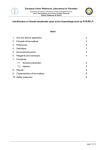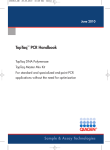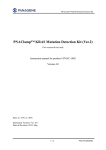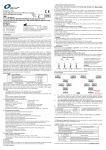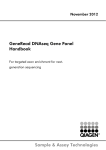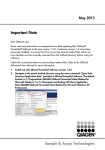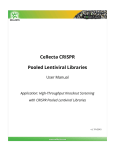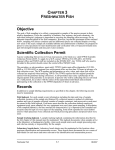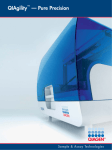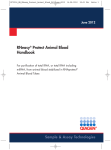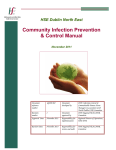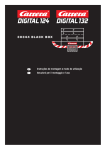Download Identification of Opisthorchis spp eggs by PCR [PDF
Transcript
European Union Reference Laboratory for Parasites Department of Infectious, Parasitic and Immunomediated Diseases Unit of Gastroenteric and Tissue Parasitic Diseases Istituto Superiore di Sanità IDENTIFICATION OF Opisthorchis sp. EGGS BY PCR INDEX 1 AIM AND FIELD OF APPLICATION 2 2 PRINCIPLE OF THE METHOD 2 3 REFERENCES 3 4 DEFINITIONS 3 5 DEVICES/INSTRUMENTS 3 6 REAGENTS AND CHEMICALS 5 7 PROCEDURE 7 7.1 Sample preparation 7.2 Method 7 7 8 RESULTS 13 9 CHARACTERISTICS OF THE METHOD 14 10 SAFETY MEASURES 14 page 1 of 11 European Union Reference Laboratory for Parasites Department of Infectious, Parasitic and Immunomediated Diseases Unit of Gastroenteric and Tissue Parasitic Diseases Istituto Superiore di Sanità 1 AIM AND FIELD OF APPLICATION This document describes a method to determine the presence of Opisthorchis sp. eggs by PCR. The method can be applied to faecal samples of human or animal origin, preserved in ethanol. 2 PRINCIPLE OF THE METHOD The Polymerase Chain Reaction (PCR) is a molecular biology technique allowing for the amplification of specific nucleic acid fragments, which initial and terminal nucleotide sequences are known (oligonucleotide pair). If a species (or a genotype) has its own characteristic DNA portion, due to its composition and/or dimension, it is possible to choose an oligonucleotide pair allowing for its amplification. The PCR amplification is characterized by a high sensitivity and specificity. Tremadotes of the genus Opisthorchis are transmitted to humans through the consumption of raw freshwater fishe of the family Cyprinidae. The Opisthorchis genus includes the species O. felineus and O. viverrini, the first species is widespread in Europe and in the Russian Federation; the second one is endemic in Southeast Asia (Laos, Cambodia, Thailand). The adult parasites colonize the biliary ducts and cause tiredness, loss of weight, and diarrhoea e. In advanced cases portal hypertension, chronic inflammation and hyperplasia of the biliary tract develop, including the possible invasion of the pancreatic duct. Cirrhosis of the liver, or cholangiocarcinoma, may arise to complicate the late clinical picture of the disease. The diagnosis of opistorchiasis is made by microscopic examination of faecal samples for the detection of the parasite eggs. The diagnosis can be difficult due to the reduced number of eggs, the intermittent egg production, their small size and their morphology. The Opisthorchis sp. eggs may be confused with those of phylogenetically related trematodes or may not be recognized at all, if the examination is carried out by not experienced analyst. Molecular methods based on PCR allow to identify the presence of parasite eggs in faecal samples of human and animal origin, even when their number is too low to be detected by microscopy. The Internal Transcribed Spacer 2 (ITS2), placed among the ribosomal genes 5.8S and 28S is a molecular marker frequently used in molecular diagnosis. The ITS1 does not codificate any proteic or functional product therefore is more subjected to genetic variability, this characteristic making it a very useful diagnostic tool. By applying the PCR analysis to a specific fragment of the ITS2 gene, it’s possible to discriminate between Opishtorchis and Clonorchis genera. Table A shows the size of the ITS2 gene fragments obtained from 3 species of the Opisthorchidae family by amplification with specific oligonucleotide pair. Table A – Size of the amplification product of the ITS2 gene fragment (in base pairs) from each species O. felineus O. viverrini C. sinensis 248 248 255 page 2 of 11 European Union Reference Laboratory for Parasites Department of Infectious, Parasitic and Immunomediated Diseases Unit of Gastroenteric and Tissue Parasitic Diseases Istituto Superiore di Sanità 3 REFERENCES Muller B., Schmidt J., Mehlhorn H. PCR diagnosis of infections with different species of Opisthorchidae using a rapid clean-up procedure for stool samples and specific primers. Parasitol Res (2007) 100:905-909. Qiagen: QIAamp DNA Stool Handbook, Second edition April 2010. QIAxcel User manual version 1.0, edition 2008. 4 DEFINITIONS ITS2 (Internal Transcribed Spacer 2), intergenic spacer placed among 5.8S and 28S genes. Oligonucleotide, a short sequence (15/30 nucleotides) used for the amplification of a specific DNA fragment. Set O, mix of 2 oligonucleotides amplifying a fragment of the ITS2 gene from species belonging to the Opisthorchidae family. Reference DNA, genomic DNA extracted from O. felineus adults. DNA extraction positive control, aliquots of human faeces spiked with O. felineus eggs, processed in the same working session of test samples, to verify the efficacy of the DNA extraction. Positive amplification control, a reference DNA; this control is used in the amplification session to verify the efficacy of the PCR. Negative amplification control, reagent grade water; this control is used in the amplification session to verify the efficacy of the PCR. The definitions and terminology used in the UNI EN ISO 22174 standard are applied in the present protocol. 5 DEVICES/INSTRUMENTS 5.1 Refrigerated bench centrifuge for 1.5-2.0 mL tubes, min 20.000 x g 5.2 Freezer ≤ -15°C 5.3 Thermoblock with vibration, temperature range +25-100°C 5.4 PCR thermocycler 5.5 Refrigerator, temperature range +1-8°C 5.6 Horizontal electrophoretic apparatus 5.7 Digital imaging system 5.8 Adjustable volume pipettes, range: 1-10μL, 2-20μL, 20-100μL, 50-200μL, 200-1000μL 5.9 Analytical grade water system production, resistivity ≥ 18M /cm page 3 of 11 European Union Reference Laboratory for Parasites Department of Infectious, Parasitic and Immunomediated Diseases Unit of Gastroenteric and Tissue Parasitic Diseases Istituto Superiore di Sanità 5.10 Vortex 5.11 Analytical balance, readability 0.1g 5.12 UV Transilluminator 5.13 Orbital shaker 5.14 Qiaxcel, capillary vertical electrophoretic apparatus 6 REAGENTS AND CHEMICALS 6.1 Lysis buffer. Commercially available solution: QIAamp DNA Stool Handbook, labelled as ‘ASL solution’. Store according to the manufacturer’s recommendations. 6.2 InhibitEX Tablet. Commercially available reagent: QIAamp DNA Stool Handbook, QIAGEN. Store according to the manufacturer’s recommendations. 6.3 Proteinase K. Commercially available reagent: QIAamp DNA Stool Handbook, QIAGEN. Store according to the manufacturer’s recommendations. 6.4 Lysis buffer. Commercially available solution: QIAamp DNA Stool Handbook, labelled as ‘AL solution’. Store according to the manufacturer’s recommendations. 6.5 Absolute ethanol. Commercially available reagent. 6.6 Recovery column. Commercially available material: QIAamp DNA Stool Handbook, QIAGEN, labelled as QIAmp Mini Spin Columns. 6.7 Collection tubes. Commercially available material: QIAamp DNA Stool Handbook, QIAGEN, labelled as Collection tubes (2 ml). 6.8 Washing buffers. Commercially available solutions: QIAamp DNA Stool Handbook, QIAGEN. Prepare according to the manufacturer’s recommendations, and label the solutions as ‘AW1’and ’AW2’. Store according to the manufacturer’s recommendations. 6.9 Elution buffer. Commercially available solution: QIAamp DNA Stool Handbook, QIAGEN, labelled as ‘Buffer AE’. Store according to the manufacturer’s recommendations. 6.10 PCR master mix. Commercially available solution to perform PCR amplification experiment (for example: Qiagen HotStarTaq Master Mix Kit). Store according to the manufacturer’s recommendations. If large volumes of PCR master mix are purchased, the product can be divided into 1-2 mL aliquots. 6.11 SetO. The oligonucleotide mixture (6.12) used for the PCR; the mixture is obtained combining an equal volume of the oligonucleotides OpITS2f and OpITS2r (6.12). The final concentration corresponds to 10 pmol/μL of each oligonucleotide; 100 μL aliquots are prepared and stored frozen (5.2) for up to 24 months. 6.12 Oligonucleotides. Commercially available reagents (Table B); the lyophilized products is reconstituted with analytical grade water (5.9) according to the manufacturer’s recommendations, at a concentration of 100 pmol/μL. This operation is recorded, dated and signed, on the oligonucleotide technical sheet provided by the manufacturer. The lyophilized product can be stored frozen (5.2) for up to 5 years; the reconstituted product can be stored frozen (5.2) for up to 24 months. Table B. Oligonucleotide sequences of set-O (6.11), their codes and amplified nucleotide sequence. page 4 of 11 European Union Reference Laboratory for Parasites Department of Infectious, Parasitic and Immunomediated Diseases Unit of Gastroenteric and Tissue Parasitic Diseases Istituto Superiore di Sanità Oligonucleotide sequences 5’-CGAGGGTCGGCTTATAAAC-3’ 5’- AGCCTCAACCAAAGACAAAG-3’ Codes Amplified sequence OpITS2f OpITS2r ITS2 6.13 Loading buffer 6x, Commercially available product allowing electrophoresis of DNA molecules. It can be included in the PCR master mix (see 6.6). Store according to the manufacturer’s recommendations. 6.14 Agarose, Commercially available product suitable for performing DNA molecule electrophoresis. Store according to the manufacturer’s recommendations. 6.15 50x TAE solution, Commercially available product (2M Tris-acetate, 50mM EDTA, pH 8.2– 8.4 at 25°C). Store at room temperature for up to 24 months. 6.16 1x TAE solution, 1000 mL preparation: take 20 mL of the 50x solution and bring to 1000 mL with water. The solution must prepared prior to the use. 6.17 Ethidium bromide solution, Commercially available product 10 mg/L. For the working condition, dilute 1:100,000; for 100 mL solution, add 1.0 μL. Store according to the manufacturer’s recommendations NOTE: Ethidium bromide is potentially mutagenic, carcinogenic and teratogenic; wear disposable gloves and handle very carefully the solution containing this substance. 6.18 L50, Commercially available product containing markers for DNA molecular weight multiple of 50 bp. All commercial products containing molecules of multiples of 50 bp within the 50500 bp range can be used. Store refrigerated (5.5) according to manufacturer’s recommendations. 6.19 Milli-Q grade water. Resistivity ≥ 18 Mohm/cm 6.20 QIAxcel kit: Commercially available product from Qiagen codes from 929002 to 929004. Include a cartridge for samples separation by electrophoresis and solutions for samples preparation and run. Store refrigerated (5.5) according to manufacturer’s recommendations. 6.21 Alignment marker: Commercially available product from Qiagen containing markers for samples alignment after the run. Store refrigerated (5.5) according to manufacturer’s recommendations. 6.22 DNA size marker: Commercially available product from Qiagen containing markers for DNA molecular weight, codes from 929550 to 929558. Store refrigerated (5.5) according to manufacturer’s recommendations. 6.23 Faecal reference sample: human faeces spiked with O. felineus eggs. Store frozen (5.2) for up to 5 years. 6.24 Reference DNA of O. felineus: genomic DNA extracted from adults of O. felineus. Store frozen (5.2) for up to 5 years. 7 7.1 PROCEDURE Sample preparation The faecal sample be preserved in ethanol, the tubes must be intact and show no sign of spillage. If the conditions are not suitable, the test will not be performed. page 5 of 11 European Union Reference Laboratory for Parasites Department of Infectious, Parasitic and Immunomediated Diseases Unit of Gastroenteric and Tissue Parasitic Diseases Istituto Superiore di Sanità 7.2 Method 7.2.1 DNA extraction from the faecal sediment sample If not otherwise stated, the procedure is performed at room temperature. Each working session requires that a reference sample (6.21) is processed for DNA extraction and labelled as “positive extraction control”. a) Transfer 1.0 ml of the faecal sample containing 50% ethanol in a 1.5 ml tube b) Centrifuge (5.1) the tubes at 6.000 x g for 5 minutes c) Discard the supernatant and add enough water to reconstitute the starting volume d) Centrifuge again as in point ‘b’ e) Repeat the washing step as in point ‘c’ f) Transfer 200 µL of each faecal sample in 2 ml Eppendorf tubes g) Add 1.4 ml of lysis buffer ASL (6.1) and vortex to homogenize the sample h) Incubate for 10 minutes at 95°C in the thermomixer (5.3). Set the shaking at 1.400 rpm during the lysis step i) Centrifuge (5.1) for 1 minute at 20.000 x g j) Transfer the supernatant in clean tubes k) Add an InhibitEX tablet (6.2) and vortex for 1 minute l) Incubate for 1 minute m) Centrifuge (5.1) for 3 minutes at 20.000 x g n) Add 25 µL of Proteinase K (6.3) into 2.0 ml tubes o) Take the supernatant (from point m) and add it to the tube containing the Proteinase K p) Add 600 µL of lysis buffer AL (6.4) to the same tube q) Incubate in a thermomixer (5.3) for 10 minutes at 70°C r) Add 600 µL of absolute ethanol and vortex briefly s) For each sample, put one recovery column (6.6) into a collection tube (6.7) t) Transfer 600 µL of lysate (from point r) into the recovery column (6.6) and centrifuge (5.1) for 1 minute at 13.400 g u) Discard the collection tube and put the recovery column (6.6) into a fresh collection tube (6.7) v) Repeat step t-u two more times z) Add 500 µL of washing buffer AW1 (6.8) to the recovery column and centrifuge (5.1) for 1 minute at 20.000 x g a1) Discard the collection tube and put the recovery column (6.6) into a fresh collection tube (6.7) b1) Add 500 µL of washing buffer AW2 (6.8) to the recovery column and centrifuge (5.1) for 3 minutes at 20.000 x g c1) Transfer the recovery column (6.6) in a 1.5 ml Eppendorf tube d1) Add 200 µL of elution buffer AE (6.9) to the recovery column (6.6) and incubate for 1-2 minutes e1) Centrifuge (5.1) for 1 minute at 20.000 x g, discard the recovery column (6.6), and save the Eppendorf tubes containing the DNA extracts page 6 of 11 European Union Reference Laboratory for Parasites Department of Infectious, Parasitic and Immunomediated Diseases Unit of Gastroenteric and Tissue Parasitic Diseases Istituto Superiore di Sanità f1) The DNA extracts prepared in this way are labeled ‘DNA/faecal sample’ and are stored frozen (5.2) for up to 5 years. 7.2.2 PCR amplification If not specified otherwise, keep tubes on ice, use aerosol-free tips and wear disposable gloves. At each working session, use a positive and a negative amplification control. Use reference DNA (6.24) as positive control and water (6.19) as negative control. The following procedure uses a PCR master mix at a 2X concentration. If the concentration is different, modify the procedure following the manufacturer’s recommendations. a) Thaw: DNA/faecal samples, 2x PCR MasterMix (6.10), SetO (6.11), amplification positive control (reference DNA, 6.24). b) Mark with a progressive number an adequate number of 0.2 μL PCR tubes. c) Prepare an adequate cumulative volume of amplification mix. Calculate the volume on the basis of a single sample amplification mix (Table C) and of the total number of samples plus three (1 for the DNA purification control, 1 for the positive amplification control and 1 for the negative control). Table C. Amplification mix for a single sample: components and volumes 2x PCR MasterMix (6.10) 15 µL H2O 12 µL SetO (6.11) 1 µL Total 28 µL d) Mix the amplification mix by vortexing and centrifuge (5.1) at maximum speed for a few seconds e) Transfer 28 μL of the cumulative amplification mix to each PCR tube (point “b”). f) Add 2 μL of the DNA/faecal samples to be tested to each tube. g) Close the tubes, mix by vortexing and centrifuge (5.1) at maximum speed for a few seconds h) Start the amplification cycle (Table G) on the thermocycler device (5.4); wait until the temperature reaches 94°C and insert the tubes in the thermoblock by pausing the instrument. Close the lid and restart the program. Table D. Amplification cycle Pre-denaturation 5 min/94°C Amplification 30 s/94°C 30 s/55°C 60 s/72°C Number of cycles Final extension 40 7 min/72°C page 7 of 11 European Union Reference Laboratory for Parasites Department of Infectious, Parasitic and Immunomediated Diseases Unit of Gastroenteric and Tissue Parasitic Diseases Istituto Superiore di Sanità i) At the end of the amplification step, centrifuge (5.1) the tubes at maximum speed for a few seconds. l) Leave the tubes on ice or in a refrigerator (5.5) before the electrophoresis. 7.2.3 Visualisation of results a) Assemble the electrophoresis apparatus (5.6) according to the manufacturer’s recommendations. For the gel preparation, use a comb suited for the number of samples to be tested. b) Weight (5.11) 2 g of agarose (6.14) and add it to 100 mL of TAE 1x (6.16) in a glass beaker. c) Gently resuspend the agarose powder by rotation. d) Boil the agarose suspension for 30 sec. If the solution is not homogeneous, continue to boil for another 30 sec. e) Restore with water the volume lost during boiling. f) Allow the agarose solution to cool. g) Before it solidifies (at about 47°C), add 1.0 μL of ethidium bromide solution (6.17). h) Shake gently to dissolve uniformly the ethidium bromide and pour the agarose in the gel tray previously prepared (point “a”). i) Wait for the gel to solidify, which requires at least 30 min. j) Place the tray with the gel in the electrophoresis apparatus. k) Cover the gel with TAE 1x bufer (6.16) and gently pull out the comb. l) Load in each well 10 μL of the amplification product (7.2.1 point “n”), following the progressive numbering of the tubes (7.2.2 point “b”). m) Load the first and the last well with 10 μL of the L50 solution (6.18). n) Connect the electrophoresis apparatus with the power supply (5.6) and set 10 v/cm of gel. o) Run the gel for about 30 min or until the fastest dye contained in the loading buffer reaches a distance of 1 cm from the gel border. p) After 30 min, switch off the power supply, place the gel under UV illumination (5.12) and check the band separation. The electrophoresis run is adequate if it is possible to distinguish easily all bands of the molecular weight marker ranging from 250 to 2000 bp. If the separation is incomplete, continue the run. q) At the end of the run, transfer the gel to the imaging system (5.7) and print the result. 7.2.4 Interpretation of the PCR amplification results on agarose gel The size of the amplification bands revealed by the electrophoresis is evaluated by comparison with the reference molecular weight L50 (6.18) and with the positive extraction and amplification controls (6.24, 6.25). The visual evaluation is considered sufficient and adequate (see Table A). The amplification test is considered valid if: 1) the amplification of the positive control 6.24) shows an amplification product as in Table A; 2) the amplification of the negative control does not show any amplification product or, eventually, only bands related to unincorporated oligonucleotides and/or primer dimers page 8 of 11 European Union Reference Laboratory for Parasites Department of Infectious, Parasitic and Immunomediated Diseases Unit of Gastroenteric and Tissue Parasitic Diseases Istituto Superiore di Sanità In case the sample shows one or more unexpected bands (differing from those in Table A) or if it shows no amplification, the presence of inhibitors will be tested by mixing equal volumes of O. felineus reference DNA (6.24) and test sample DNA (7.2.1 f1), and amplifying the mix by PCR reaction as described in the paragraph 7.2.7. 7.2.5 Visualisation of results on capillary electrophoresis a) Switch on the Qiaxcel instrument (5.14) and launch the software (BioCalculator) on the connected PC. b) Access to “Instrument control” panel by the menu “File”. c) Move the tube tray to the access position by selecting “Change Buffer” from the “Instrument control” panel. d) Check the presence of 12 tubes, containing at least 10 µL of the “Alignment Marker” (6.21), in the MARKER1 position of the buffers bowl. Then move the tube tray to the working position by selecting “Park” from the “Instrument control” panel”. e) Put the samples (minimum volume 10 µL) in rows of 12 starting from line “A”. If necessary, add an appropriate number of tubes containing QX DNA dilution buffer (minimum volume 10 µL) contained in the QIAxcel kit (6.20) to complete the row. f) For each round of analysis (including a maximun of 8 runs of 12 samples each), a tube containing DNA size marker (6.22) must be added. g) Set run parameters in the “Instrument control” panel as follow: “Method”= 0M500 “Sample”= sample code “Pos”= starting line “Time”= leave empty “Runs”= number of runs “User ID”= Mi-08 “Plate ID”= operator’s name h) Check off the 12 “Chan” boxes. i) Check off the “Automatically analyze after data acquisition” box. j) Push “Run” button to start the run. k) At the end of the run, close the software and switch off the instrument. 7.2.6 Interpretation of the PCR amplification results on capillary electrophoresis The data analysis shall consider only those bands satisfying the following requirements: 1) Band size bigger than 50 bp; 2) Comprised between the two Alignment marker bands (6.21); 3) Intensity of the emission peak greater than a threshold value of 5%. In case of overlapped peaks, only the peak showing the higher intensity will be considered; if peak values are comparable, the result is rejected. The size of the amplification bands revealed by the electrophoresis is evaluated by: page 9 of 11 European Union Reference Laboratory for Parasites Department of Infectious, Parasitic and Immunomediated Diseases Unit of Gastroenteric and Tissue Parasitic Diseases Istituto Superiore di Sanità i) visual comparison with the “DNA size marker” (6.22) and with the positive extraction and amplification controls on the virtual gel; ii) comparison between the band size calculated by the software and the expected band size; If the sample shows one or more unexpected bands (differing from those in Table A) or no amplification, the presence of inhibitors will be tested by mixing equal volumes of O. felineus reference DNA (6.24) and test sample DNA (7.2.1 f1), and amplifying the mix by PCR reaction as described in the paragraph 7.2.7. 7.2.7 Test for the presence of inhibitors by PCR with O. felineus reference DNA If nor otherwise stated, keep tubes on ice, use tips with barrier and wear disposable gloves. At each working session, use a positive and a negative amplification control. Use reference DNA (6.24) as positive control and water (6.19) as negative control. The following procedure uses a PCR master mix at a 2X concentration. If the concentration is different, modify the procedure following the manufacturer’s recommendations. a) Thaw: DNA/faecal samples, 2x PCR MasterMix (6.10), SetO (6.11), amplification positive control (reference DNA, 6.24). b) Mark with a progressive number an adequate number of 0.2 μL PCR tubes. c) Prepare an adequate cumulative volume of amplification mix. Calculate the volume on the basis of a single sample amplification mix (Table F) and of the total number of samples plus two (1 for the positive amplification control and 1 for the negative control). Table E– Amplification mix for a single sample: components and volumes 2x PCR MasterMix (6.10) 15 µL H2O 10 µL SetO (6.11) 1 µL Totale 26 µL d) Mix the amplification mix by vortexing and centrifuge (5.1) at maximum speed for a few seconds. e) Transfer 26 μL of the cumulative amplification mix to each PCR tube (point “b”). f) Add 2 μL of reference DNA (6.24) and 2 μL of the DNA/faecal samples to be tested to each tube. g) Close the tubes, mix by vortexing and centrifuge (5.1) at maximum speed for a few seconds. h) Start the amplification cycle (Table I) on the thermocycler device (5.4); wait until the temperature reaches 95°C and insert the tubes in the thermoblock by pausing the instrument. Close the lid and restart the cycle. page 10 of 11 European Union Reference Laboratory for Parasites Department of Infectious, Parasitic and Immunomediated Diseases Unit of Gastroenteric and Tissue Parasitic Diseases Istituto Superiore di Sanità Table F – Amplification cycle Pre-denaturation 5 min/94°C Amplification 60 s/94°C 60 s/62°C 60 s/72°C Number of cycles Final extension 40 7 min/72°C i) At the end of the amplification step, centrifuge (5.1) the tubes at maximum speed for a few seconds. i) Leave the tubes on ice or in a refrigerator (5.5) before the electrophoresis. 7.2.8 Results To visualize the results, follow the procedure described at point 7.2.3. and 7.2.5 7.2.9 Interpretation of the PCR amplification results on agarose gel and capillary electrophoresis If the expected 248 bp fragment from O. felineus will be amplified, the presence of inhibitors will be excluded and the sample will be judged as “negative”. On the contrary, a new DNA extraction from the test sample will be performed. 8 RESULTS The results are expressed as follows: If the amplification product show a size of 248 bp, the sample is classified “positive for Opisthorchis spp”. If the test is valid and the sample shows amplification products different from those reported in table A, the sample is classified “negative”. 9 CHARACTERISTICS OF THE METHOD The present method has been characterized in terms of sensitivity, specificity and repeatability, and the validation process confirmed that the method is suitable for the specific aim. 10. SAFETY MEASURES This method has to be carried out only by authorized personnel. The analyst shall wear individual protection devices (gloves and lab coat) while performing the test. page 11 of 11











